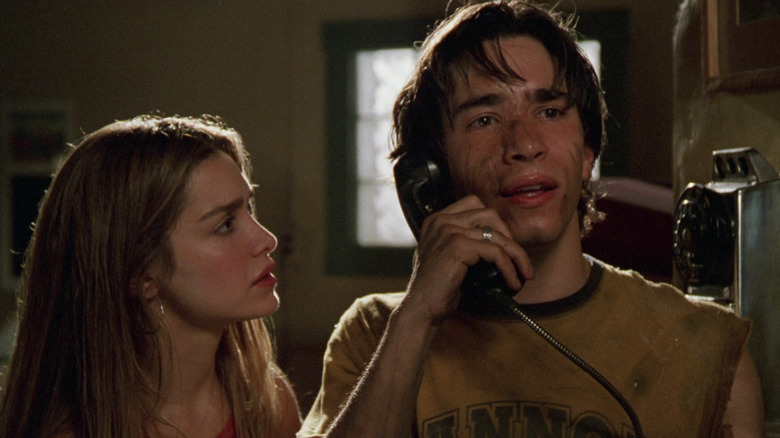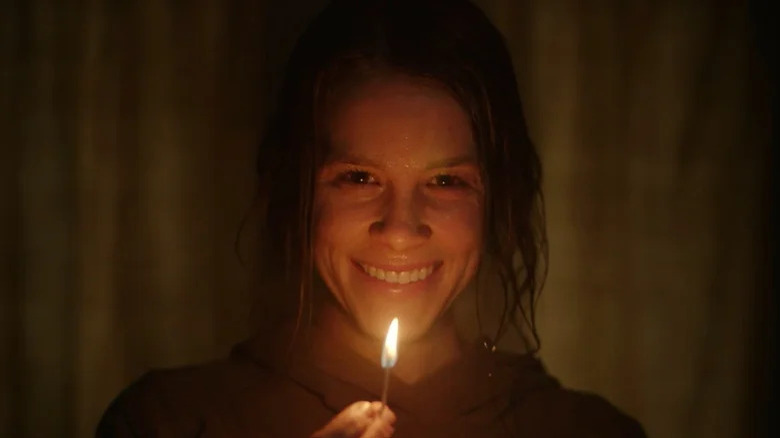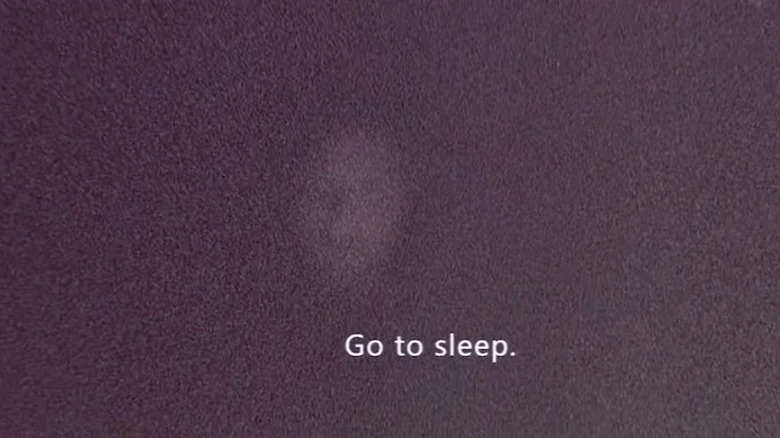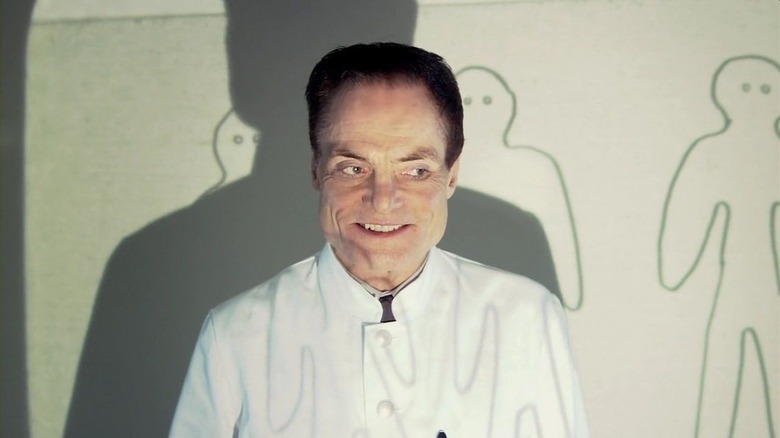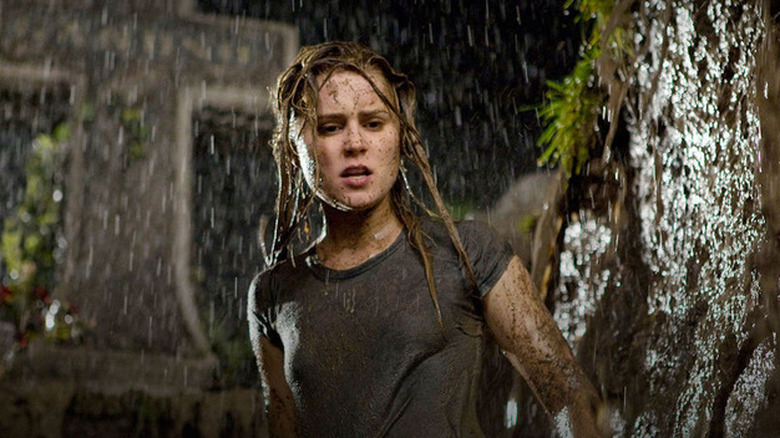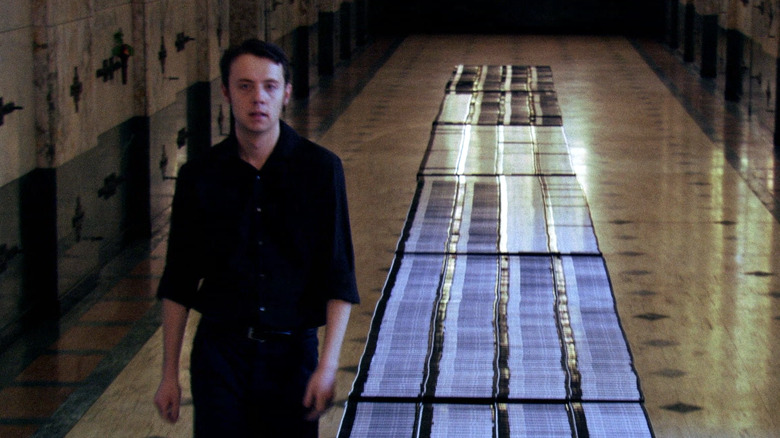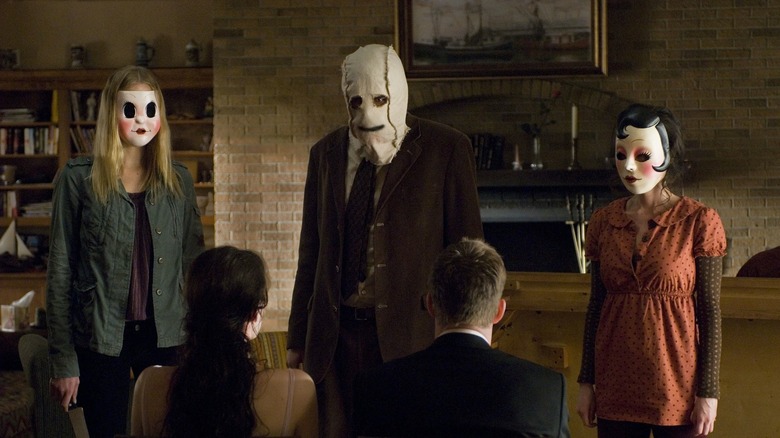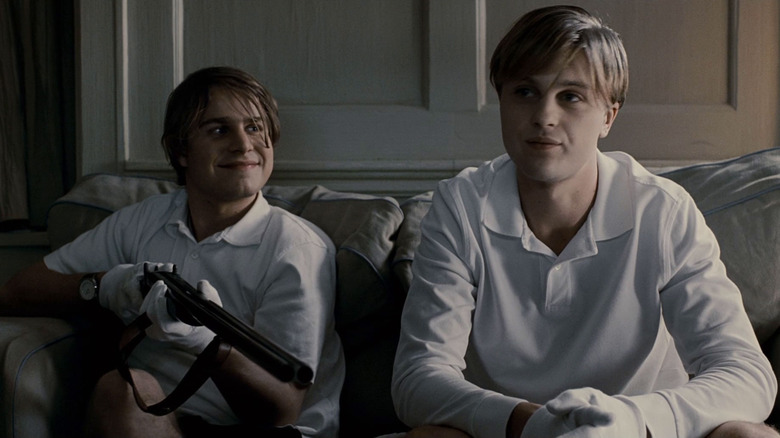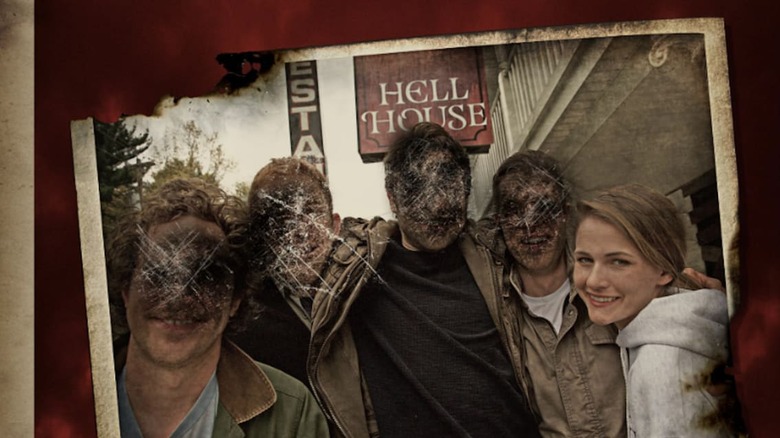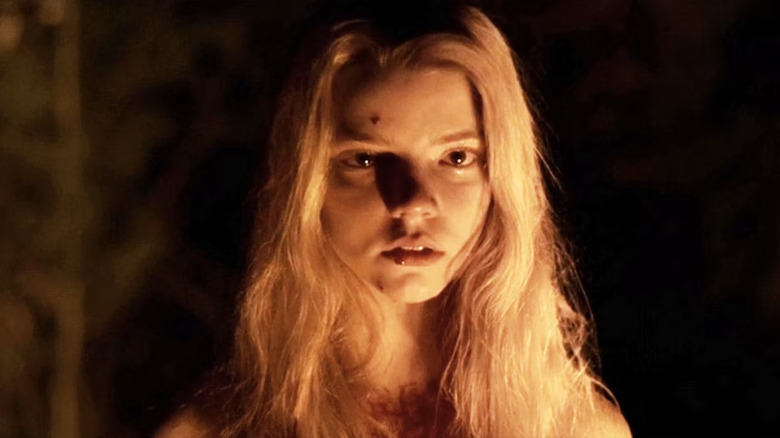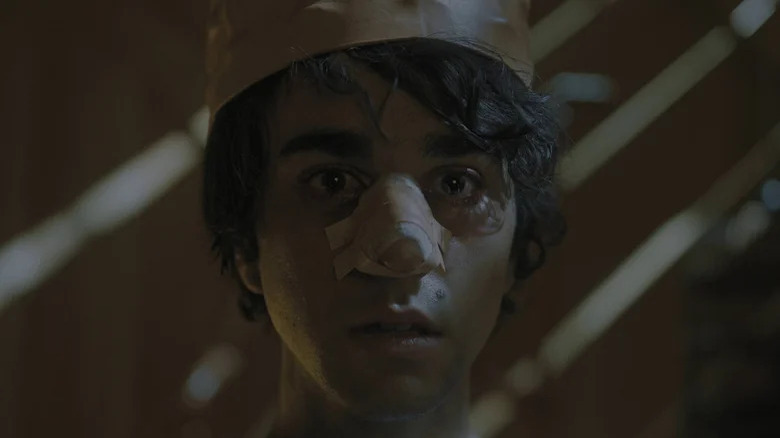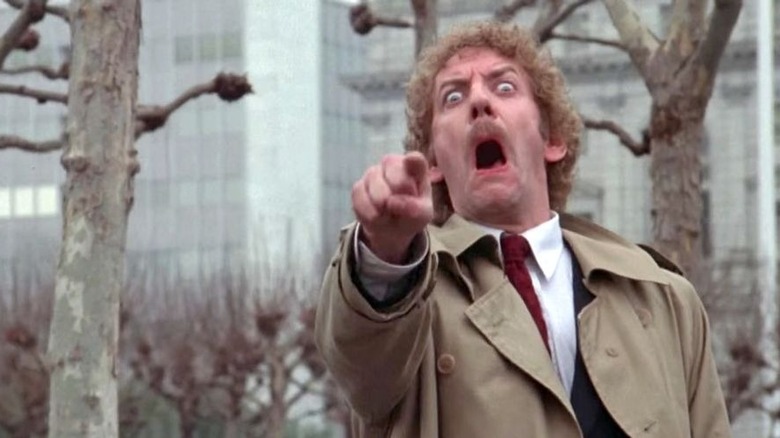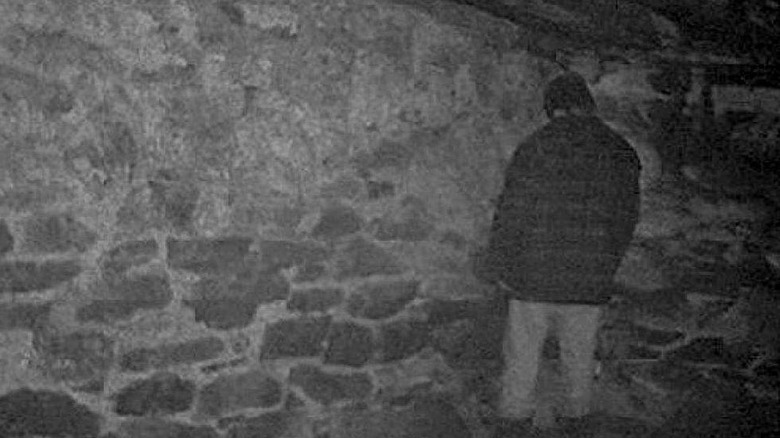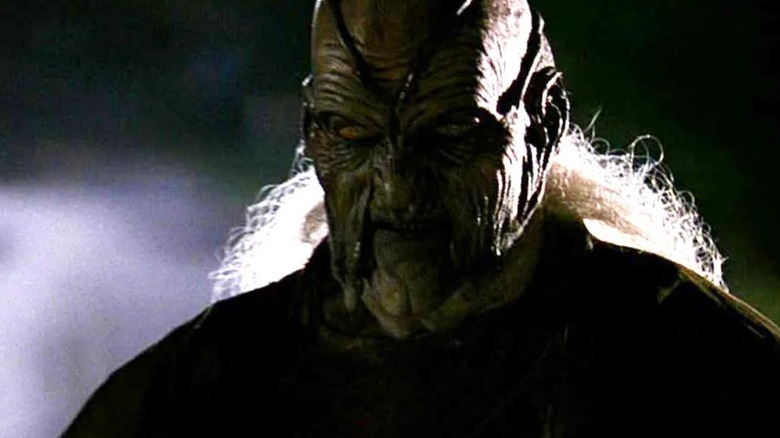13 Horror Films Where The Evil Threat Triumphs
Horror films aren't usually known for having happy endings, but most people have come to expect that by this stage of the game. Unlike romantic comedies or superhero movies, horror is one of the only genres heavily predicated on human misery, disturbing behavior, and excessive bodily dismemberment.
In most horror movies, instead of boy meets girl, it's more than likely going to be boy meets girl and then eviscerates her in the toolshed. As opposed to seeing the hero ride off into the sunset, you'll probably see the hero violently decapitated just before the credits roll. Additionally, when it comes to horror films, it's not at all uncommon for nearly every single character, regardless of age or race, to die gruesomely.
While the good guys sometimes win, that's very rarely the case. These are just a few noteworthy horror films that opted to leave their audiences feeling as disturbed and emotionally drained as humanly possible. Steel yourself and hold on tight, because these are 16 horror films where the evil threat triumphs.
Smile
"Smile" has quickly become an instant favorite for many horror fans and it isn't hard to see why. From its simplistic gimmick to the ingenious way it was marketed, "Smile" had a lot of factors driving its box office success.
The film follows Rose (Sosie Bacon), a therapist who, after witnessing the horrific death of her patient, realizes that a dark presence is stalking her. This is very obviously connected to her patient smiling grotesquely just moments before taking her own life. Now everywhere Rose goes, she begins seeing more and more people boasting the same creepy and unflinching perma-grin. It's soon explained that Rose has been cursed by an entity that feeds off trauma, something she's revealed to have boatloads of.
In the film's climax, we're led to believe that Rose has broken the cycle due to facing a past trauma involving her deceased mother. However, in a cruel twist, it's revealed that this was just trickery from the evil entity, which then reveals itself in grand fashion. The entity entrances Rose and forces itself down her throat, possessing her. The film concludes with Rose, now sporting the same depraved smile, dowsing herself in gasoline before lighting herself on fire in front of her ex-boyfriend Joel (Kyle Gallner).
Skinamarink
Whether you were horrified or bored senseless by it, "Skinamarink" certainly had the horror world abuzz following its release. Kyle Edward Ball's lo-fi look at childhood nightmares was arguably more style than substance, but its style is definitely worth writing home about.
The film concerns two siblings, Kevin (Lucas Paul) and Kaylee (Dali Rose Tetreault), who wake up one night to discover that their father is mysteriously gone. After a few days camped out in front of their television's glow, they start to hear a strange voice beckoning them to come upstairs, a voice that Kaylee soon follows. Following a haunting interaction with an aberration of her missing mother, Kaylee has her eyes and mouth stolen from her in a jarring reveal.
Kevin soon finds himself also at the mercy of this mysterious entity, even being forced to stab his own eye. It's eventually revealed that Kevin has been at the mercy of this unexplained entity for 572 days, stuck in a never-ending loop of suffering. This is haunting because, despite never actually seeing much of Kevin onscreen, it's clear just how scared and helpless he is. When Kevin asks the entity its name, it remains silent, leaving the audience, much like Kevin, in a state of fear and confusion as the film ends.
The Human Centipede (First Sequence)
Dutch director Tom Six's "The Human Centipede (First Sequence)" follows Lindsay (Ashley C. Williams) and Jenny (Ashlynn Yennie), tourists from New York, who find themselves stuck with a flat tire while traversing Germany. Stuck out in the rain, their late-night trek leads them to the doorstep of Dr. Josef Heiter (Dieter Laser), who invites them inside.
However, a couple of drugged beverages later, the girls find themselves strapped to hospital beds, informed of the fate that awaits them. Heiter, a once-leading surgeon in separating Siamese twins, looks to use the girls, as well as another kidnapped tourist named Katsuro, to create the titular human centipede by surgically joining them mouth to rear. Despite some escape attempts, the surgery goes ahead as planned and the centipede's construction is completed, much to Heiter's sick jubilation.
Sadly there is no happy ending for anyone as, during the climax, Katsuro takes his own life, Jenny dies of sepsis and Heiter is shot by a police officer. The film ends on the image of a tearful Lindsay, stuck in the middle of two corpses, unlikely to escape her nightmarish situation. While the film has been analyzed as a metaphor for the horrors of Nazism, its sick sense of humor suggests that Tom Six was simply interested in seeing how far he could push the genre — and audiences.
Drag Me To Hell
Sam Raimi's "Drag Me To Hell" follows Christina (Alison Lohman), a bank loan officer who one day crosses the wrong client: a Roma woman who, after being denied a loan extension by Christina, curses her. Now Christina has only three days before her eternal soul is literally dragged to hell. The film goes out of its way to really ingratiate Christina to the viewer, so you end up wanting her to come out of it okay. Along the way she learns that she can undo the hex by giving her shirt button, which the old woman placed the curse on, to someone else. Christina ends up burying the button in the old woman's grave, which seems to work, and everything seems to be back on track as the film starts to wrap up.
However, prior to getting on a train, her boyfriend Clay (Justin Long) produces an envelope that he'd found in her car. In a tragic twist, it seems that Christina buried the wrong envelope and, still possessing the button, is still very much cursed. As if on cue, a screaming Christina falls onto the train tracks just as the demons of hell rise up to drag her down into the fiery depths. The film ends with a traumatized and tearful Clay silently wondering what in the literal hell just happened. It's as high concept and cruel an ending as only "The Evil Dead" creator Sam Raimi could provide.
The Poughkeepsie Tapes
"The Poughkeepsie Tapes" tells the story of a killer, real name never revealed, whose cache of 800-plus videotapes is discovered by the police in Poughkeepsie, New York. The tapes themselves paint a horrific and very detailed image of the killer, who goes as far as to abduct and kill children. The film largely predicates itself on the torture of one victim, Cheryl (Stacy Chbosky), who is horrifically beaten into mental submission by the killer. We later learn that Cheryl, suffering some immense Stockholm syndrome, takes her own life only two weeks after being rescued. This section of the film is basically an endurance test in disturbing imagery and ideas, which makes the final act all the more depressing.
Despite many efforts from law enforcement, the killer ultimately proves to be too smart to be captured, even planting DNA evidence to temporarily frame someone else. The film ends with them finding another tape, this one left in Cheryl's coffin, that shows yet another victim being tortured. After the credits, we're shown what was on the tape, with the killer telling his latest hostage that she'll die the next time she blinks. You may find "The Poughkeepsie Tapes" either terrifying or needlessly sadistic, but either take is supported by the film's unnervingly low-budget esthetic.
The Strangers
When it comes to home invasion movies, you'd be hard-pressed to find one as viscerally unnerving as "The Strangers." The film's director, Bryan Bertino, noted that the film was in fact inspired by some well-known home invasions and even a few incidents from his own childhood.
The film's events follow James (Scott Speedman) and Kristen (Liv Tyler), a couple with a strained relationship who arrive at the former's childhood home following a friend's wedding. As they settle in for the night, a knock at the door awakens them and they are greeted by a strange woman who asks, "Is Tamara here?" She seems to leaves after being informed that no one with that name is on the premises, but she soon returns with two masked compatriots.
After several intense struggles, the strangers eventually subdue the couple and have them both at their mercy. When asked by Kristen why they are doing this, one of the strangers simply answers, "Because you were home." They then stab James and Kristen, leaving them in pools of their own blood, before driving off with one of the strangers noting, "It'll be easier next time." It's a masterfully handled ending and one that leaves you feeling just as helpless as poor James and Kristen — esepcially since the random nature of the attack goes unexplained.
Funny Games
The plot of "Funny Games" finds George Farber (Tim Roth), his wife Ann (Naomi Watts), and their son Georgie (Devon Gearhart) in the crosshairs of two criminals named Peter (Brady Corbet) and Paul (Michael Pitt). The duo present themselves as normal at first, even asking for mundane things like some eggs before eventually dropping their kindly ruse. As the film goes on, we get a very clear picture of Peter and Paul as two sociopaths who treat killing as some nonchalant game — even breaking the fourth wall at one point to rewind the film and change the outcome of one scene.
The film's most powerful asset is the cruelty it shows towards its main characters, treating none of them with even a shred of mercy. Peter and Paul proceed to kill both Georgie and George before tying up poor Ann and casually dumping her in a lake to drown. The film concludes with the duo knocking on someone else's door, ready to start their games all over again.
"Funny Games" is a divisive film for many, not surprising given the film is one of the more unrelentingly unpleasant that the genre has to offer. Bad things happen to good people, suggests director Michael Haneke (remaking his own earlier German-language version), and by watching, the viewer themselves is complicit in the horror.
Hell House LLC
Via found footage and faux documentary segments, "Hell House LLC" tells the tale of the ill-fated Hell House, a haunted house attraction set up in a hotel called the Abaddon. Things go badly wrong on the attraction's opening night, resulting in the death of 15 customers and all but one of the Hell House team. The remaining team member, Sara (Ryan Jennifer Jones), is subsequently interviewed by a documentarian, Diane Graves (Alice Bahlke), who she shows the footage to.
Through the footage we get to see the extremely charming and funny interactions of the crew, which makes what happens next all the more heartbreaking. Not only is the crew menaced by the ghosts of past guests, but their prop clown dummies begin moving at night. Each member of the crew ultimately meets with a terrible fate, including Sara. In a creepy twist, we see that she has been a ghost the whole time, and has led Diane Graves to her doom. "Hell House LLC" is no masterpiece, but it successfully plays on our fascination with haunted attractions and their seemingly "safe" scares.
The Witch
"The Witch" follows a Puritan family who are driven out of their extremely religious community and assailed by forces beyond their comprehension. Not long after their excommunication, the family's youngest child, Samuel, is snatched in broad daylight and killed by a witch. Soon after, dark omens and paranormal incidents begin plaguing the family, eventually claiming the lives of patriarch William (Ralph Ineson), pre-teen son Caleb (Harvey Scrimshaw), and young twins Mercy (Ellie Grainger) and Jonas (Lucas Dawson). The mother, Katherine (Kate Dickie), mentally frayed by the demise of her family, attacks eldest daughter Thomasin (Anya Taylor-Joy), blaming her for their misfortunes and resulting in her daughter killing her with a farm tool.
Her family destroyed, Thomasin is approached by a demonic goat named Black Phillip who, after transforming into a man, asks her, "Wouldst thou like to live deliciously?" He instructs her to strip naked and sign her name in a demonic book. Thomasin then ventures into the forest and joins in a witches' circle, laughing maniacally as she rises off the ground. In a strange way, it's almost a subversively happy ending, with Thomasin abandoning her oppressive Puritan ways in favor of a life of free will and pagan pleasures.
Hereditary
"Hereditary" follows the Graham family — Annie (Toni Collette), her husband Steve (Gabriel Byrne), their teenage son Peter (Alex Wolff) and his younger sister Charlie (Milly Shapiro). The family has recently suffered a loss in the form of Annie's mother who, as we learn throughout the film, was very secretive and controlling. However, tragedy hits once again when Charlie is accidentally decapitated by a telephone pole while Peter is driving them home from a party. This sets in motion the plans of what is revealed to be a cult that Annie's mother presided over. It seems they've been seeking a proper vessel for their deity, Paimon, for years and Peter is now their prime target.
Despite Annie's best efforts to stop this, not only is Steve burned alive but she finds herself possessed and subsequently decapitated with piano wire. Peter is then possessed by Paimon after jumping out a window, waking up just in time to see Annie's decapitated body levitate into Charlie's treehouse. He climbs up and is met by a sizable group of naked cultists who begin to praise him as their new king. By the time "Hereditary" ends, you really get the sense of just how doomed the Grahams were from the very beginning. This sense of perpetual hopelessness and familial tragedy are both themes that Aster has incorporated into his subsequent theatrical films, "MidSommar" and "Beau is Afraid."
Invasion of the Body Snatchers
The 1978 remake of "Invasion of the Body Snatchers" starts with a race of liquid-like aliens arriving on Earth, taking the form of seed pods that morph into pink flowers. One of these flowers is subsequently taken home by a scientist named Elizabeth Driscoll (Brooke Adams), where it assimilates her boyfriend Geoffrey (Art Hindle). After he exhibits strange behaviors, Elizabeth soon suspects him to be a duplicate, a suspicion she shares with her colleague, Matthew Bennell (Donald Sutherland). It doesn't take too long for the pods to begin assimilating and replacing people on a large scale. Despite trying to warn the government and local law enforcement, Elizabeth and Matthew's efforts are in vain as the pod people are already taking those institutions over, making the situation all the more hopeless.
Eventually, Elizabeth herself is assimilated, leaving Matthew alone, knowing that when he next falls asleep, he too will be assimilated. The film concludes with Nancy (Veronica Cartwright), the wife of one of Matthew's friends, encountering him near City Hall, seeming perfectly normal. However, Matthew lets out the pod people's horrific shriek, terrifying Nancy and ending the film on a ghastly note. "Invasion of the Body Snatchers" twists the Cold War paranoia of the original movie into a meditation on the '70s' culture of self-absorption, in which we are forced to wonder whether we truly know the people around us, including our closest family and friends.
The Blair Witch Project
"The Blair Witch Project" is told entirely from the found-footage POV of three film students — Heather, Mike, and Josh — who venture into the woods of Burkittsville, Maryland in pursuit of the area's infamous Blair Witch. Legends indicate that the witch caused a recluse named Rustin Parr to murder seven children in the basement of his secluded home in the 1940s. Over the course of the film, the trio become hopelessly lost in the woods, with Josh going missing ahead of the film's climax amidst an increasing sense of the three friends' desperation.
The ending sees Heather and Mike, hearing Josh's screams, enter an isolated, abandonted house, which may be Rustin Parr's, in search of their friend. After Mike is attacked in the basement, Heather follows him downstairs and is met with the sight of him facing the corner, just like Parr's past victims. Heather then screams at the top of her lungs at an unseen menace before dropping the camera, which runs out of film and shuts off, with the trio's final fate unknown. The abrupt ending is a perfect capper to a film that has the viewer questioning what's real and what isn't from the very start, by not offering the kind of closure that a more traditionally conceived film would provide.
Jeepers Creepers
"Jeepers Creepers" follows two siblings, Trish (Gina Philips) and Darry Jenner (Justin Long), who are heading home from spring break and find themselves in a world of trouble. While driving through some rural areas of Florida, Trish and Darry stumble across the lair of an evil entity known as the Creeper (Jonathan Breck). This creature seems to emerge every 23 years for 23 days to feast on the body parts of humans, which it then adds to its own body.
it soon becomes apparent that the Creeper is dead set on claiming one of the siblings for his macabre purposes. That sadly turns out to be Darry, who is kidnapped by the Creeper despite the best efforts of Trish and Darry to escape. The film ends with the camera gliding through an abandoned factory as the titular song plays and we hear Darry screaming. We then see Darry's body with the back of its head and eyes ripped out, his eyes now visible in the Creeper's head as the film cuts to black. The film's script does a solid job of portraying Trish and Darry as very likable siblings, making Darry's fate all the more heartbreaking — especially since he and Trish stumble upon the Creeper in such random fashion.
